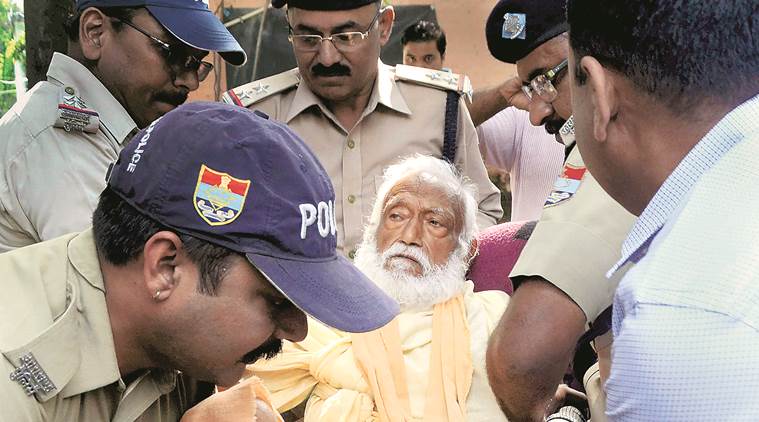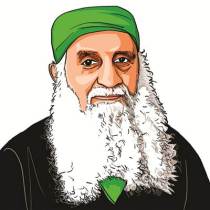Scientist And Tapasvi
G D Agarwal lived and died to awaken the collective conscience for the Ganga.

Environmentalist G D Agarwal being taken to hospital on Wednesday.
India lost her true Gangaputra, Swami Sanand, also known as Dr G D Agrawal, on October 11, the 112th day of his fast-unto-death seeking effective action from the Government of India for the conservation and protection of the Ganga.
GD, as many affectionately addressed him, was a good and rare human being. Dressed in ordinary khadi, before he took sanyas in 2011, his appearance belied his logical mind, formidable knowledge and high accomplishments. He began his career in the 1950s as a design engineer with UP’s irrigation department, rose to head the environmental engineering department at IIT-Kanpur, was the first member-secretary of India’s Central Pollution Control Board and a member of numerous official committees for setting policies and regulatory mechanisms to improve India’s environmental quality.
GD epitomised simple living and high thinking. A greater part of his last 25 years were spent in Chitrakoot, where he became an honorary professor at the Mahatma Gandhi Grameen Vishwavidyalaya. This eminent scientist swept his own floors, washed his clothes and cooked his meals in a spartan 200-sq ft cottage. A bicycle, an ordinary state transport bus or second-class train compartment were his preferred modes of transportation.
A former IIT-K student described GD as “India’s first technically qualified environmentalist”. After graduating in civil engineering from the University of Roorkee (now IIT-Roorkee), GD obtained an MS and PhD in environmental engineering from the University of California at Berkeley. At heart, GD was an activist. He was more attracted to experimenting with possible solutions rather than theorising. Over the years he mentored many young development activists. The more well-known ones include Dunu Roy (IIT-Bombay, ‘67), who first headed the Indian branch of FREA, set up the innovative Vidushak Karkhana and later, The Hazards Centre, New Delhi; Anil Agrawal (IIT-Kanpur,’70) founder of Centre for Science & Environment and waterman Rajendra Singh.
In 2007 on a visit to the Ganga’s shrine at Gangotri, GD became aware of the plans to build a series of four dams upstream of Tehri, besides the Maneri-Bhali-I project. He realised that these new dams would destroy the only pristine stretch of the Ganga. After considering a number of options, GD announced his decision on April 14, 2008, to undertake a fast-unto-death from mid-June that year unless all the dam building activities on the Ganga between Gangotri and Maneri were permanently stopped.
His first fast brought the issue of environmental flows to the centrestage of the hydro-power production discourse. It led to the designation of the Ganga as India’s national river. His second fast in 2009 led to the formation of the National Ganga River Basin Authority. The third one in 2010 forced the UPA government to cancel all the three new projects between Gangotri and Uttarkashi and the establishment of the Bhagirathi Eco-Sensitive Zone.
In February 2018, after waiting for almost four years, Swami Sanand wrote to Prime Minister Narendra Modi reminding him of his announcement, “Mujhe Ma Ganga ne bulaya hai,” after winning the Varanasi Lok Sabha seat. He placed four demands before the PM, and wrote that he would fast-unto-death from June 22 if they were not fulfilled. These were: (i) Present a comprehensive Bill to Parliament, based on a draft prepared by the Ganga Mahasabha in 2012, to effectively conserve and protect the Ganga; (ii) Stop all hydro-electric projects under construction or proposed in the upper reaches of the Ganga and its six headstream tributaries; (iii) Ban river-bed sand mining in the main stem of the Ganga and (iv) Form an autonomous body of capable and committed persons to ensure the well-being of the river.
The PM never responded. On September 9, Swami Sanand announced that he would give up drinking water from October 9. Negotiations thereafter with government officials, cabinet ministers and senior leaders of the BJP and RSS proved fruitless. The iron-willed Swami Sanand chose martyrdom in the hope that it would awaken the conscience of the government and the people of India.
The writer is former director, People’s Science Institute, Dehradun and was a close associate of Swami Sanand






































No hay comentarios:
Publicar un comentario